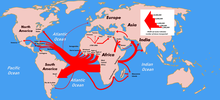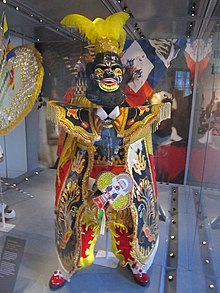Afro-Bolivians
Afroboliviano (Spanish) | |
|---|---|
 Flag of the Afro-Bolivian Monarchy | |
 An Afro-Bolivian woman dressed in traditional Andean clothing in Coroico | |
| Total population | |
| 23,330 (2012 census)[1] 0.23% of the Bolivian population | |
| Regions with significant populations | |
| Los Yungas | |
| Languages | |
| Spanish | |
| Religion | |
| Catholicism • Traditional | |
| Related ethnic groups | |
| West Africans, Central Africans, Afro-Latin Americans and Bolivians |
Afro-Bolivians (Spanish: Afrobolivianos), also known as Black Bolivians (Spanish: Bolivianos Negros), are Bolivians who have predominantly or total Sub-Saharan African ancestry and therefore the descriptive "Afro-Bolivian" may refer to historical or cultural elements in Bolivia thought to emanate from their community. It can also refer to the combining of African and other cultural elements found in Bolivian society such as religion, music, language, the arts, and class culture. The Afro-Bolivians are recognized as one of the constituent ethnic groups of Bolivia by the country's government, and are ceremonially led by a king who traces his descent back to a line of monarchs that reigned in Africa during the medieval period. They numbered 23,000 according to the 2012 census.[2]
History of slavery in Bolivia
[edit]
Slaves were brought as early as the 16th century in Bolivia to work in mines.[3] In Potosí during the 17th century 30,000 Africans were brought to work in the mines from which the total population of Potosí which numbered around 200,000.[4] Slaves were more expensive in Bolivia then other parts of the Spanish colonies costing upwards to 800 pesos.[5] This was due to the fact that they had to be bought from slave ports in the coastal region of the Spanish empire and had to trek from cities like Cartagena, Montevideo, and Buenos Aires to Bolivia.[6]

Slaves were put to work in difficult conditions.[7]


Many newly brought slaves died due to the weather. Coca leaves helped with alleviating altitude sickness.[8] Just like the mines of Potosí, coca plantations became a cash-crop of the region. Thousands of slaves were shipped to cultivate and process coca leaves on Haciendas, like the ancestors of Julio Pinedo.[9]
The Yungas
[edit]
Their move occurred during the year 1827 (although its enforcement being postponed to 1851),[10] The indigenous Aymara people and mestizos lived in the Yungas before the Afro-Bolivians.[11]
Culture
[edit]Saya music
[edit]
The word saya originates from Kikongo nsaya, referring to the act of singing while performing communal work.[citation needed][12]


Caporales
[edit]
Caporales is a dance popular in the Andean region of Bolivia. It gained popularity in 1969 by the Estrada Pacheco brothers, inspired by the character of the 'Caporal' or "overseer" of which, historically black slaves, usually mixed race, wore boots and held a whip, the dance originates from the region of the Yungas in Bolivia. However, elements of the dance (such as the costumes) were of European origin.[13]
Morenada
[edit]
Morenada is a folkloric dance in Bolivia. The dance originated with sufferings of the African slaves brought to Bolivia in order to work in the Silver Mines of Potosí. The enormous tongue of the dark masks was meant to represent the physical state of these mines workers and the rattling of the Matracas are frequently associated with the rattling of the slaves' chains and satirizing "white men".[14][15]
Language
[edit]Afro-Bolivians have traditionally maintained their own creole language, with links to earlier Bozal Spanish.[16][17]
Afro-Bolivian monarchy
[edit]
The Afro-Bolivian Royal House is a ceremonial monarchy officially recognized as part of the Plurinational State in Bolivia. The royal family are the descendants of an African noble line that was brought to Bolivia as slaves.[18] The founding monarch, Uchicho, was allegedly of Kongo and Senegalese origin, and was brought to the Hacienda of the Marquis de Pinedo, in the area of Los Yungas in what is now La Paz Department. Other slaves allegedly recognized him as a man of regal background (a prince from the ancient Kingdom of Kongo[19]) when seeing his torso exposed with royal tribal marks only held by royalty; he was later crowned in 1823. The monarchy still survives today and the current monarch, King Julio Pinedo, is a direct descendant of Uchicho.[20]
Keeping the culture
[edit]
Aspects such as feasts, their creole language (that has since decreolized), religion that survived through colonialism have since gone extinct, culturally, although fragments remain.[21] Afro-Bolivians due to isolation from much of Bolivia speak a dialect of Bolivian Spanish, akin to African-American Vernacular English in the United States.[22][23][17][16] Afro-Bolivians, in addition to being Roman Catholic incorporate elements of African diasporic religions such as rituals in the Macumba and Voodoo religions have influence their practice of Christianity, mainly prevalent in the towns of Chicaloma and Mururata.[24] Musical traditions such as dances, instruments, and techniques with ancestral origin in Sub-Saharan Africa, to the present day define Afro-Bolivian identity.[25][26]
Afro-Bolivians today
[edit]

They maintain their traditional culture, to the point of maintaining a continuous Afro-Bolivian monarchy currently led by Julio Pinedo at Mururata. Afro-Bolivians spread to the east in Cochabamba and Santa Cruz de la Sierra.[citation needed]

Despite the Afro-Bolivian community fervently working to preserve their culture, many Afro-Bolivians have reported experiencing severe racism and feelings of isolation from society due to intolerance. Laws that actually criminalize racism and discrimination in Afro-Bolivia have slowly been ratified as the first anti-discriminatory law (law 45) was passed in 2010 and was met with violent protesting and rioting. In 2009 President Evo Morales added amendments to the national constitution that outlined the rights of Afro-Bolivians and guaranteed the protection of such liberties. The amendments also generally extended to indigenous peoples and officially recognized Afro-Bolivians as a minority group in Bolivia despite them not being included in the national census three years later. In addition to the country's constitution being updated in 2009, President Morales created the Vice Ministry for Decolonization to create policies that criminalize racism while working to improve literacy and create better race relations in Bolivia. The Vice Ministry for Decolonization also works to dismantle colorism and racism influenced by European colonization while also promoting the philosophy of "intercultural-ity" in which citizens of the nation recognize every ethnic groups' traditions and cultural practices as contributions to society.[citation needed]
Notable Afro-Bolivians
[edit]Politics
[edit]Ceremonial monarchy
[edit]- Angélica Larrea, current Afro-Bolivian queen
- Aurora Pinedo, former Afro-Bolivian princess regent
- Bonifacio Pinedo, former Afro-Bolivian king
- Julio Pinedo, current Afro-Bolivian king
- Rolando Pinedo Larrea, current Afro-Bolivian crown prince
- Uchicho, first Afro-Bolivian king
Government
[edit]- Ancelma Perlacios, politician and activist who was the first Afro-Bolivian to serve in the Senate.
- Mónica Rey Gutiérrez, supranational delegate to the Plurinational Legislative Assembly of Bolivia
- Jorge Medina, member of the Chamber of Deputies of Bolivia
Activism
[edit]- Marfa Inofuentes, Afro-Bolivian activist
Sports
[edit]Basketball
[edit]- Josh Reaves, professional basketball player for the Dallas Mavericks of the NBA
Sports Shooting
[edit]- Rudolf Knijnenburg, Bolivian Olympic air pistol shooter
Soccer
[edit]
- Edemir Rodríguez, football player, Bolivian international
- Jairo Quinteros, football player, Bolivian international
- Demetrio Angola, football player, Bolivian international
- Leonel Morales, football player, Bolivian international
- Augusto Andaveris, football player, Bolivian international
- Ramiro Castillo, football player, Bolivian international
- Iván Castillo, football player, Bolivian international
- Gustavo Pinedo, football player, Bolivian international
- Jaime Arrascaita, football player, Bolivian international
- Joel Bejarano, football player, Bolivian youth international
- Marc Enoumba, football player, Cameroonian-born, naturalized Bolivian international
See also
[edit]External links
[edit]References
[edit]- ^ "Características de la Población – Censo 2012" [Population Characteristics – 2012 Census] (PDF) (in Spanish). Instituto Nacional de Estadística. p. 103. Archived (PDF) from the original on 30 April 2021. Retrieved 30 April 2021.
- ^ "Censo de Población y Vivienda 2012 Bolivia Características de la Población". Instituto Nacional de Estadística, República de Bolivia. p. 29. Archived from the original on 2021-08-01. Retrieved 2020-03-27.
- ^ "Afro-Bolivians". Minority Rights Group. Archived from the original on 2021-07-28. Retrieved 2021-07-28.
- ^ "Potosí Silver Mines". Atlas Obscura. Archived from the original on 2022-01-17. Retrieved 2021-07-28.
- ^ "Afro-Bolivian - Afropedea". www.afropedea.org. Archived from the original on 2022-11-28. Retrieved 2021-07-28.
- ^ "The Real Histories Directory - Slavery in Latin America". www.realhistories.org.uk. Archived from the original on 2021-01-28. Retrieved 2021-07-28.
- ^ Johnson, Charlotte (2014-02-24). "The South American slave trade". Manchester Historian. Archived from the original on 2021-07-28. Retrieved 2021-07-28.
- ^ "Afro-Bolivian - Afropedea". www.afropedea.org. Archived from the original on 2021-07-28. Retrieved 2021-07-28.
- ^ "Bolivia's Afro king leads a long-neglected group stepping out of the shadows". the Guardian. 2017-12-06. Retrieved 2021-07-28.
- ^ "Afro-Bolivians | Encyclopedia.com". www.encyclopedia.com. Archived from the original on 2021-07-28. Retrieved 2021-07-28.
- ^ "Afro Bolivia – Freedom Is Mine". Archived from the original on 2021-07-28. Retrieved 2021-07-28.
- ^ "Traditional Bolivian Music Types: Western Bolivia. Andean Music and Dances". BoliviaBella. Archived from the original on 2010-06-14. Retrieved 2021-07-28.
- ^ "Danzas autóctonas de Bolivia". 2012-02-22. Archived from the original on 2012-02-22. Retrieved 2021-07-28.
- ^ "Morenada – Bolivia Marka". boliviamarka.com. Archived from the original on 2016-11-21. Retrieved 2021-07-28.
- ^ "Morenada | Bolivian dance". Encyclopedia Britannica. Archived from the original on 2021-07-28. Retrieved 2021-07-28.
- ^ a b Lipski, John M. "El lenguaje afroboliviano: apuntes lingüísticos" (PDF) (in Spanish). Retrieved 23 November 2021.
- ^ a b "Palenquero creole and the decreolization of Bolivian Spanish" (PDF). Archived (PDF) from the original on 2011-06-24.
- ^ "El retorno del rey negro boliviano a sus raíces africanas - El País". Archived from the original on 2020-11-09. Retrieved 2021-07-28.
- ^ Busqué, Jordi. "Bolivia's little-known tribal kingdom". www.bbc.com. Archived from the original on 2021-03-16. Retrieved 2021-03-16.
- ^ "The story of Julio Pinedo, a farmer from Kongo who has been king of Afro-Bolivians since 1992". Face2Face Africa. 2021-04-27. Retrieved 2021-07-28.
- ^ Sessarego, Sandro (16 August 2013). "Historical Afro-Bolivian creole and culture". Journal of Pidgin and Creole Languages. 28 (2): 363–407. doi:10.1075/jpcl.28.2.04ses. Archived from the original on 2021-07-29. Retrieved 2021-07-29.
- ^ "Más de 500 palabras serán la base de la lengua afroboliviana - La Razón". 2018-07-01. Archived from the original on 2018-07-01. Retrieved 2021-07-29.
- ^ "Afrobolivianos recuperarán su lengua y cultura - La Razón". 2018-07-01. Archived from the original on 2018-07-01. Retrieved 2021-07-29.
- ^ "Portal de la Amazonia Boliviana". amazonia.bo. Archived from the original on 2021-07-29. Retrieved 2021-07-29.
- ^ "Afro-Bolivians | Encyclopedia.com". www.encyclopedia.com. Archived from the original on 2021-07-28. Retrieved 2021-07-29.
- ^ negression.com, Kalisha at (2017-04-24). "An Interview with Maya Jensen, Filmmaker behind 'Solidarity in Saya: An Afro-Bolivian Music Movement'". negression. Archived from the original on 2021-07-29. Retrieved 2021-07-29.
- ^ "Web Oficial de la Casa Real Afroboliviana". Archived from the original on 2024-06-17. Retrieved 2018-03-15.
